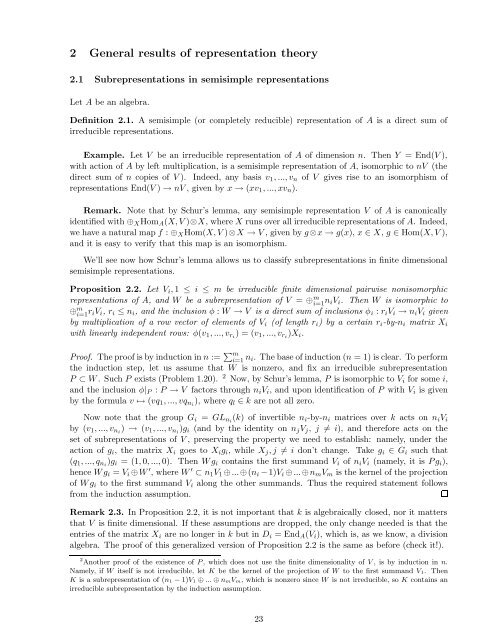Lecture notes for Introduction to Representation Theory
Lecture notes for Introduction to Representation Theory
Lecture notes for Introduction to Representation Theory
Create successful ePaper yourself
Turn your PDF publications into a flip-book with our unique Google optimized e-Paper software.
⇒<br />
⇒<br />
2 General results of representation theory<br />
2.1 Subrepresentations in semisimple representations<br />
Let A be an algebra.<br />
Definition 2.1. A semisimple (or completely reducible) representation of A is a direct sum of<br />
irreducible representations.<br />
Example. Let V be an irreducible representation of A of dimension n. Then Y = End(V ),<br />
with action of A by left multiplication, is a semisimple representation of A, isomorphic <strong>to</strong> nV (the<br />
direct sum of n copies of V ). Indeed, any basis v 1 , ..., v n of V gives rise <strong>to</strong> an isomorphism of<br />
representations End(V ) ⊃ nV , given by x ⊃ (xv 1 , ..., xv n ).<br />
Remark. Note that by Schur’s lemma, any semisimple representation V of A is canonically<br />
identified with X Hom A (X, V )X, where X runs over all irreducible representations of A. Indeed,<br />
we have a natural map f : X Hom(X, V )X ⊃ V , given by g x ⊃ g(x), x X, g Hom(X, V ),<br />
and it is easy <strong>to</strong> verify that this map is an isomorphism.<br />
We’ll see now how Schur’s lemma allows us <strong>to</strong> classify subrepresentations in finite dimensional<br />
semisimple representations.<br />
Proposition 2.2. Let V i , 1 ∗ i ∗ m be irreducible finite dimensional pairwise nonisomorphic<br />
representations of A, and W be a subrepresentation of V = m<br />
i=1 n iV i . Then W is isomorphic <strong>to</strong><br />
m<br />
i=1 r i V i , r i ∗ n i , and the inclusion θ : W ⊃ V is a direct sum of inclusions θ i : r i V i ⊃ n i V i given<br />
by multiplication of a row vec<strong>to</strong>r of elements of V i (of length r i ) by a certain r i -by-n i matrix X i<br />
with linearly independent rows: θ(v 1 , ..., v ri ) = (v 1 , ..., v ri )X i .<br />
Proof. The proof is by induction in n := ⎨ m<br />
i=1 n i. The base of induction (n = 1) is clear. To per<strong>for</strong>m<br />
the induction step, let us assume that W is nonzero, and fix an irreducible subrepresentation<br />
P → W . Such P exists (Problem 1.20). 2 Now, by Schur’s lemma, P is isomorphic <strong>to</strong> V i <strong>for</strong> some i,<br />
and the inclusion θ| P : P ⊃ V fac<strong>to</strong>rs through n i V i , and upon identification of P with V i is given<br />
by the <strong>for</strong>mula v ⊃ (vq 1 , ..., vq ni ), where q l k are not all zero.<br />
Now note that the group G i = GL ni (k) of invertible n i -by-n i matrices over k acts on n i V i<br />
by (v 1 , ..., v ni ) ⊃ (v 1 , ..., v ni )g i (and by the identity on n j V j , j = i), and there<strong>for</strong>e acts on the<br />
set of subrepresentations of V , preserving the property we need <strong>to</strong> establish: namely, under the<br />
action of g i , the matrix X i goes <strong>to</strong> X i g i , while X j , j = i don’t change. Take g i G i such that<br />
(q 1 , ..., q ni )g i = (1, 0, ..., 0). Then W g i contains the first summand V i of n i V i (namely, it is P g i ),<br />
hence W g i = V i W , where W → n 1 V 1 ... (n i − 1)V i ... n m V m is the kernel of the projection<br />
of W g i <strong>to</strong> the first summand V i along the other summands. Thus the required statement follows<br />
from the induction assumption.<br />
Remark 2.3. In Proposition 2.2, it is not important that k is algebraically closed, nor it matters<br />
that V is finite dimensional. If these assumptions are dropped, the only change needed is that the<br />
entries of the matrix X i are no longer in k but in D i = End A (V i ), which is, as we know, a division<br />
algebra. The proof of this generalized version of Proposition 2.2 is the same as be<strong>for</strong>e (check it!).<br />
2<br />
Another proof of the existence of P , which does not use the finite dimensionality of V , is by induction in n.<br />
Namely, if W itself is not irreducible, let K be the kernel of the projection of W <strong>to</strong> the first summand V 1. Then<br />
K is a subrepresentation of (n 1 − 1)V 1 ... n mV m, which is nonzero since W is not irreducible, so K contains an<br />
irreducible subrepresentation by the induction assumption.<br />
23

















